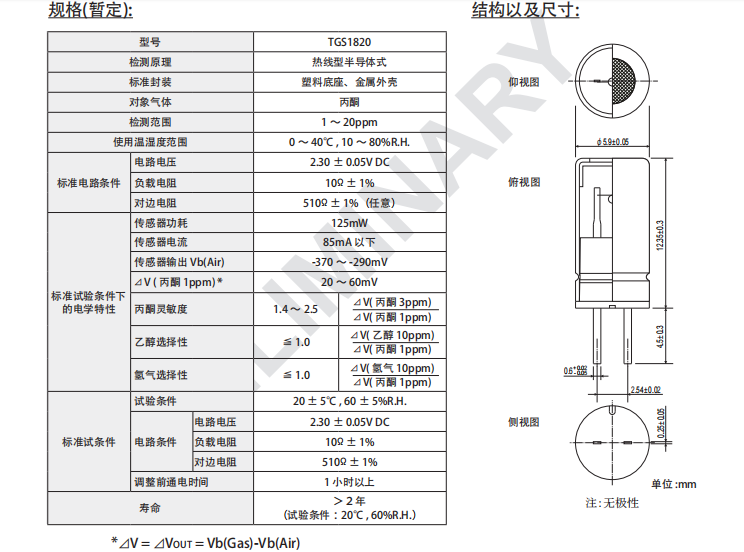bagaimana boleh kami menolong anda
With the continuous development of society and the gradual improvement of people's living standards, the public 's demands for safety, health and environmental protection have become increasingly strong. Among many fields, the demand for accurate detection of low-concentration acetone gas is particularly prominent. At this point, the advantages of oxide semiconductors are obvious. Due to its characteristics such as high sensitivity, small size, low energy consumption and cost, and easy operation, oxide semiconductors play a decisive role in acetone gas sensor applications.
The physical properties of acetone are: molecular weight 58, specific gravity 0.791, 56.2 °C, melting point - 95.4°C, vapor pressure at 20C 24.1kPa, relative steam density 2.0, flash point - 9.4°C (cup), explosion limit 2.5%-12.8%. The liquid is volatile at room temperature, completely miscible with water and other organic agents, colorless, and has a special sweet taste. Inhaling high concentrations (approximately 1000ppm) may cause slight irritation to the nasal cavity and throat. Extremely high concentrations (greater than 10000ppm) may cause headaches, weakness, drowsiness, nausea, drunkenness and vomiting.
Acetone has a wide range of applications in industry. It can be used as a good solvent for many organic substances, such as petroleum, paraffin, resin, rubber, plastic, paint, etc. At the same time, because it is cheap and miscible with water, it is also often used as an extraction agent. In addition, it is an important raw material in chemical synthesis and can be used to synthesize methyl isobutyl ketone, mesityl oxide acetic acid, diketols, etc. In addition, acetone is also a product of animal body metabolism, and its concentration can reflect the physical condition of the organism. Excessive acetone concentration in the body can cause ketosis. From this point of view, the detection of acetone gas is very necessary. Previously, the quantitative detection methods for acetone gas mainly include: gas phase or liquid chromatography, spectrophotometer method, quartz crystal microscale method, optically addressable potential sensor (LAPS) method and optical fiber .Sensor circle etc. The detection cost of these detection methods is relatively expensive, and the preparation method of the sensor is complicated. Oxide semiconductor gas sensors are widely used in the detection of various target gases due to their high sensitivity, fast response, small size, low energy consumption and cost, and simple operation. In recent years, research on acetone semiconductor materials has made some progress at home and abroad.
Acetone gas sensors can play an important role in many fields.
1. Application of acetone gas sensor in industry and public safety:
Acetone gas sensor can monitor the leakage of acetone gas in the environment and provide alarm for possible major hazards to safety and personal health.
2. Medical applications of acetone gas sensors: diagnosis and monitoring of diabetes and ketoacidosis. In patients with diabetes, the rate of fatty acid oxidation increases, prompting the liver to produce ketone bodies, and acetone is the final product of ketone body metabolism. When a large amount of ketone bodies are produced, the alkali in the body is consumed, causing ketoacidosis. Acetone in the blood passes through the porous blood vessel wall and is mixed in the exchange gas. Therefore, the concentration of acetone in the patient's exhaled gas must be proportional to the concentration of acetone in the blood, as shown in Figure 1. By detecting the concentration of acetone gas in human exhaled gas, it can be used to diagnose and monitor the condition.
3. Application of acetone gas sensor in animal husbandry:
By detecting the concentration of acetone gas in the exhalation of dairy cows, the health status of dairy cows can be monitored. For cattle in poor condition, timely measures can be taken to treat them.
4. Application of acetone gas sensor in food quality detection:
Evaluate the preservation status of food by detecting the concentration of acetone in the gas evaporated from meat products. For
accurate detection of low-concentration acetone gas, Gongcai.com recommends Japan's FIGARO acetone gas Sensor TGS1820:
Features of Japan's FIGARO gas sensor TGS1820 for detecting acetone:
high sensitivity and selectivity for acetone, low interference
from ethanol and hydrogen,
extremely fast response,
small size,
low power consumption
Japan's FIGARO gas sensor TGS1820 for detecting acetone Application:
acetone Detector
Exhaled acetone detector
Japan FIGARO Gas sensor TGS1820 used to detect acetone Parameters:

|